BY: Jaime Caldwell, President SFHHA
Usually, once every year, I take a few minutes to see what others are saying and writing about the future of healthcare. I had a few minutes last week and I looked.
I have written before on this same subject and there are many similarities between then and now. Two or three years ago, I remember writing about how AI (artificial intelligence) would benefit healthcare. I seem to remember the concerns back then were that AI would not displace workers, rather, that AI would be a supplement allowing workers to be more productive and to concentrate on duties that don’t lend themselves to an AI intervention. I also seem to remember that there was concern that we aren’t graduating workers with the skill set that they will need to coexist in an AI world.
Well, this year’s review of the literature captured even more discussion about the use of AI and blockchain in healthcare along with repeated concerns about the human interactions with technology. So, what might we be looking at in the near future?
Clinical mobility ranks near the top in terms of our future. “The digital hospital of the future won’t just be more efficient, but it will also deliver better care, be more affordable and more deeply engage patients in their treatment and recovery.” All the players in healthcare will be electronically connected, leading to a reduction in cost, improvement in quality, improvement in patient safety (reduced medication administration errors), and more providers will be using this technology to access predictive analytics to assist in the improvement of care.
The customers (patients) are part of this equation. Growing numbers of customers (77 percent) are comfortable with their healthcare providers using mobile devices in their care. There are also growing numbers of customers tracking their own health metrics through either their mobile phones or wearable devices. Perhaps even more important in this discussion, 95 percent of customers will be willing to share their health metrics with their providers.
Pharmaceutics will also play a significant role in this evolution. As we continue to refine the analytics used to analyze the mountains of health data we are collecting, trends will guide healthcare providers in the optimal use of pharmaceuticals to treat various diseases. “Researchers have trained machines to recognize distinct patterns that indicate how a person will metabolize drugs, enabling them to more accurately predict how effective medication will be. Using AI to determine if someone will respond positively to a given treatment is particularly useful in oncology and neurology, where researchers can help doctors select treatments specific to a patient’s needs.”
If you want to see change in healthcare, wait a day! Genomic analysis, robotics, AI in medical decision support, and, maybe, 3D printed tissues and blood vessels are right around the corner. So, what are people saying about the next couple of decades? The Economist brought together a panel of experts to look at just those long-range change issues. The results are regionalized (U.S., EU, Asia, and Other) and I will mention just a few. Some make perfect sense and others invoke concern. I think that most can see 3D printing as an up-and-coming technology with 3D printers able to create needed replacement organs. I think that nanotechnology also makes sense with devices and treatments delivered through that route. How about brain/computer interfaces? It seems to me that we are already proceeding along this path.
How about hospital redesign? We are clearly seeing that evolve even today. It won’t be long before hospitals will only treat the sickest of the sick, needing reduced patient room space and more space for the growing use of robotics and streamlined treatment processes with high use of technology.
With so many aging over the next couple of decades, more research will be focused on the aging process and how to create aging situations that incorporate increased monitoring and personal accountability.
Lastly, and one that creates some concern, in three of the four geographic areas, designer babies are identified by significant percentages as a focus of research. I guess that this is inevitable as our understanding of the data becomes better and better.
Change is inevitable and we will continue to live it every day!


























